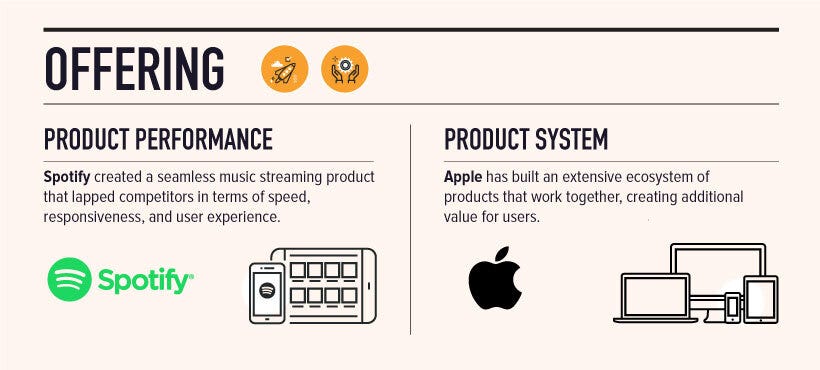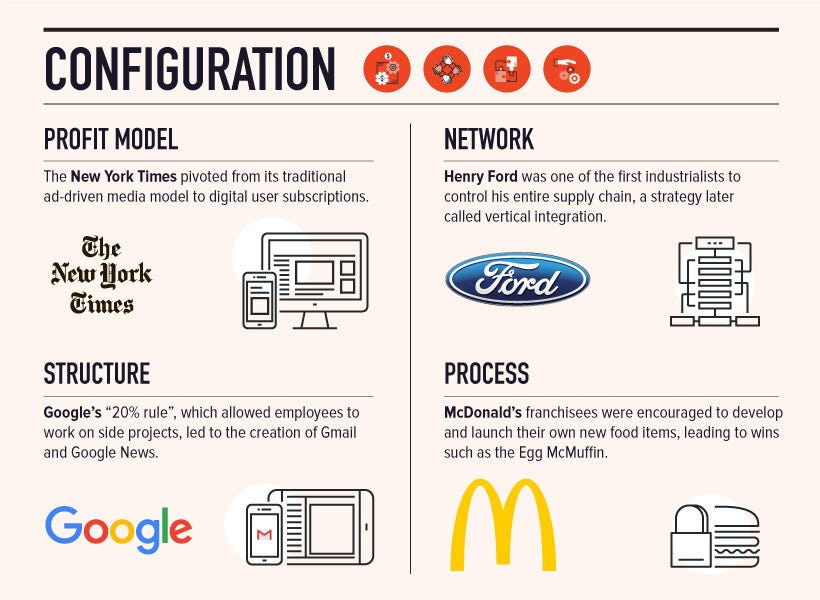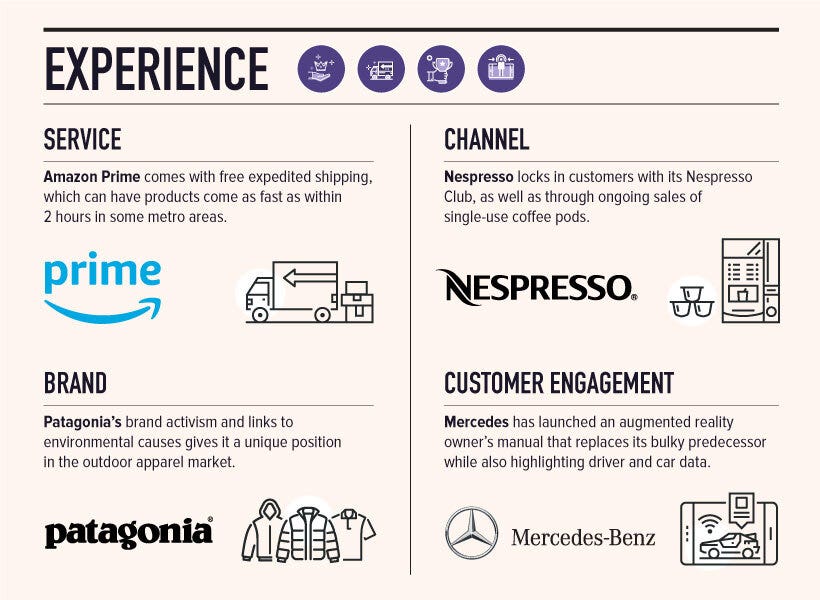Innovation is crucial for the long-term success of any company. However, when most people think of innovation, they tend to focus on technological advancements or new functionalities. While those are important, they represent only a small fraction of the broader scope of innovation. In fact, there are many different types of innovation, including brand perception, supply chain optimization, and ecosystem integration. The true goal of innovation is to achieve organic and sustainable growth in companies, and the examples of Patagonia, Apple, and Inditex demonstrate how innovation can give businesses a competitive advantage.
In this post, we will delve into a framework I discovered a few years ago that has helped me to understand how different areas of experimentation potential create more or less value. This powerful framework breaks down each of these areas into highly individualized components, providing a comprehensive understanding of the various dimensions of innovation.
“The pace and ability at which an organization is able to effectively innovate will be the determining factor of competitiveness in the future. The future is now.” - Kaihan Krippendorff
Welcome to Edelweiss Capital Research! If you are new here, join us to receive investment analyses, economic pills, and investing frameworks by subscribing below:
Many companies claim to be embracing innovation nowadays, but it's not always clear why. Innovation has become a trendy marketing term, but it's important to understand that it's ultimately a process by which a company seeks to achieve long-term competitive advantages. According to Drucker (2001), innovation is the task of endowing human and material resources with a new and greater wealth-producing capacity. Proponents of the Austrian School of Economics also emphasize the entrepreneurial attitude of continually seeking, discovering, creating, or realizing new ends as a fundamental aspect of human action.
While many executives prioritize innovation as a strategic objective, they often focus solely on disruptive innovation and consider it a success only if it matches customer needs. However, effective innovation often starts small and evolves over time, as suggested by Eric Ries in The Startup Way and Drucker in earlier works.
Large companies may struggle to become leading innovators if they don't have the proper culture in place. Startups, on the other hand, are often born out of attempts to solve a problem in an innovative way. It's important to note that innovation isn't just about technological advancements and new functionalities - there are many dimensions to consider.
In fact, Keeley et al. (2013) identified 10 dimensions of innovation after studying over 2,000 innovation processes throughout history.
Offering
The kind of innovation that everyone thinks about - the most obvious, but also one of the most complicated to achieve. It usually requires a huge amount of capital and the competitive advantages obtained are generally short-lived over time. That’s why it is important to highlight the need to combine innovations in multiple areas to create much more stable competitive advantages.
Within this group, two dimensions can be distinguished:
Product performance: This dimension involves creating new products or features. While product performance innovation may generate value for consumers, it is often short-lived in terms of competitive advantage. A classic example of this is the Roomba (iRobot) robot vacuum cleaner, which made the product category popular but did not generate a lasting competitive advantage. Many competitors soon copied the product, leading to the commoditization of the market and reducing margins. Nokia, too, was the market leader but failed to keep up with the disruptive innovation brought by the iPhone, leading to the decline of its leadership position. Therefore, while product performance innovation is what most managers and startups think about, it is often one of the least important in achieving competitive advantages.
Product system: This dimension involves creating an ecosystem of products, also known as the product ecosystem. Apple, for instance, has created an ecosystem among its products that has generated enormous value for its users - seamless integration between different products. This has created one of the most lasting competitive advantages: the switching cost. Once a high-value Apple customer is “trapped” in the ecosystem, Apple has developed one of the best businesses on Earth - the Apple Store, with margins close to 80%. The Apple ecosystem is a great example of how product system innovation can lead to long-term competitive advantage.
Configuration
Contrary to the previous ones, the following dimensions of innovation happen behind the scenes. The consumer is not able to see them, because they focus more on the operational part of the business development. However, all of them can have a potential impact on the user experience and, over time, enable the acquisition of enormous competitive advantages.
Business Model: the way a company is making money. It focuses on how a company can convert its offering and other value propositions into cash. That is, increases the ability to appropriate a greater part of the value generated. This is something that makes many startups fail: they may be generating a lot of value, but they are not able to monetize it. For this reason, innovative profit models manage to demonstrate a great knowledge of the client's needs by achieving a new generation of revenues. Many traditional industries have been disrupted by new business models, such as media entertainment (from Blockbuster to Netflix), Spotify, the press, etc.
Network: it is the use of third parties processes, technologies, products, channels, and brands to innovate their own offering. These are the different possibilities that a company has to capitalize on its own assets while at the same time creating synergies with others. An example of this type of innovation could be the alliance between Renault and Nissan, (Yoshino & Fagan, 2003), although this is not going through its best days. Another one could be the vertical integration of activities undertaken by Tesla with the self-production and mining of minerals necessary for the development of its batteries, innovating in the automobile industry, used to several decentralization via a huge network of different specialized suppliers.
Structure: Innovation in structure is related to how a company aligns its assets and talent to increase productivity and gain an advantage over competitors. In traditional industries, such as banking, incumbents often face challenges in implementing innovation due to their bureaucratic structures, high-cost structure, and slow decision-making processes. This has led to the emergence of "neo-banks" that have disrupted the traditional banking industry by providing innovative structures that align with the digital age. These neo-banks, such as N26, Revolut, and Monzo, have been able to offer a seamless and user-friendly experience to customers, unlike traditional banks that have struggled to match the pace of innovation due to their rigid organizational structures. As a result, traditional banks are losing market share and are now forced to adapt their structures to remain competitive in the face of technological disruption.
Process: Innovation processes usually come from the very base of a company's operations. In general, operations are carried out following the Agile methodology, allowing the ability to quickly adapt to changing market conditions. Inditex’s supply chain and logistics network revolution ended with the industry standard of designing collections semesters in advance. They were able to decrease the product development cycle to just 2 weeks (from the design phase to have the clothes in the stores), and that has given them a competitive advantage that its competitors were not able to match for years (D'Andrea & Arnold, 2003).
Experience
This type of innovation is directly related to customer experience and service and must, therefore, be carried out with special care. As Buffett has mentioned many times, even if it can take up to 20 years to build a reputation, it will only take 5 min to ruin it.
Service: It is about expanding the value that you generate, with the product that you offer, through the service. This innovation category focuses on identifying and addressing customer pain points throughout the entire customer journey. Amazon is a great example of a company that excels in this area. With its free return policy, for instance, Amazon eliminated the risk for customers who were hesitant about purchasing products online. By allowing customers to try out products in their own homes, Amazon removed one of the biggest barriers to online shopping. Additionally, Amazon's one-click payment system, Prime membership program, and one-day shipping options all contribute to creating a seamless and convenient customer experience.
Channel: how you make the customers feel the unique experience of buying something from you. It is indeed very related to luxury brands. Why do customers go to Tiffany or Louis Vuitton to buy new products if they are available online? How are you able to make the customer feel special and thankful when they are buying something from you at a huge price.
But it is not limited to luxury brands. While copying the coffee capsule/pods from Nespresso was easy, replicating the entire Nespresso customer experience was not as simple. Nespresso created an immersive experience for their customers, from the boutique stores to the sleek design of the coffee machines. The Nespresso Club offers personalized service and benefits, such as free shipping and exclusive promotions, which make customers feel special and appreciated. The company also created a recycling program to make the customers feel like they are contributing to a sustainable environment. As you see, it is not only about product development, it is about a whole new moat around the castle.
Brand: creating a strong brand image can make customers prefer your product over the competition, even if it's more expensive or inferior in quality (Kapferer, 2012). This is often achieved through careful strategies that prioritize long-term objectives over short-term gains, and can even transform everyday products into luxury or premium items. Take luxury fashion brands for example, they never go on sale and sometimes prefer to burn their unsold inventory rather than offer it at lower prices. And let's not forget about Apple, whose iPhone is so widespread yet continues to be perceived as an exclusive product, topping the charts as one of the world's most valuable brands (Swant, 2020). Another great example is Patagonia, a brand that has attracted a wider audience through its pro-sustainability and environmental initiatives while maintaining its premium appeal to mountaineers and (let's face it) trendy finance guys from New York. However, it's important to note that brand pricing power can be mistaken for short-lived trends, like the case of Balenciaga or even Patagonia ¿?
Customer Engagement: how to foster your customer engagement and have them come back to your offerings more time. While examples like Alphabet, Facebook (Whatsapp), and Amazon come to mind, it is interesting to analyze how other companies have leveraged customer engagement to gain a competitive advantage.
Another company that has excelled in customer engagement is Domino's Pizza Inc. Despite being a fast-food chain, their stock price has outperformed even high-tech companies such as Google and Facebook. This was achieved through a focus on product quality improvement and a digital transformation of the food-ordering process. By using digital platforms and machine learning, Domino's was able to continually improve its products and enhance the customer experience, with over 60% of orders being placed via digital channels (Harvard Business Review Analytic Services, 2018).
Innovation is often associated with groundbreaking technological advancements that transform the world, but it encompasses much more than that. The different types of innovation seek to achieve organic and sustainable growth for companies, enabling them to gain a competitive advantage in the market.
However, in today's disruptive era of technology, are the competitive advantages the same as they were 50 years ago when heavy industry dominated the major stock indexes? The answer is no. Innovation is constantly evolving, and companies must adapt and innovate to stay ahead of the competition.
While traditional industries may have dominated in the past, technology is now the driving force behind many successful companies. For instance, companies like Apple, Amazon, and Tesla have disrupted their respective industries by leveraging technology in innovative ways.
Therefore, it's important for companies to embrace innovation, not just in terms of technology, but also in their business models, processes, and customer engagement strategies, to achieve sustainable growth and stay competitive in the ever-changing business landscape.
If you enjoyed this piece, please give it a like and share!
Thanks for reading Edelweiss Capital Research! Subscribe for free to receive new posts and support our work.
If you want to stay in touch with more frequent economic/investing-related content, give us a follow on Twitter @Edelweiss_Cap. We are happy to receive suggestions on how we can improve our work.
References
Arthur D Little & Match Maker Ventures. (2019). The age of collaboration II: Pain or gain?
Barsh, J., Capozzi, M., & Mendonca, L. (2007). How companies approach innovation. McKinsey Global Survey.
D’Andrea, G., & Arnold, D. (2003, March). Zara. Harvard Business School, Case 503-050.
de Jong, M., Marston, N., & Roth, E. (2015, April). The eight essentials of innovation. McKinsey: Strategy and Corporate Finance Practice.
de Jong, M., & van Dijk, M. (2015, July). Disrupting beliefs: A new approach to business- model innovation. McKinsey: Strategy and Corporate Finance Practice.
Drucker, P. (2001). The Essential Drucker. Harper Business.
Galloway, S. (2017). The four. Transworld Publishers.
Greenwald, B., & Kahn, J. (2007). Competition Demystified: A Radically Simplified Approach to Business Strategy. Portfolio.
Harvard Business Review Analytic Services. (2018). Using Digital Platforms and Artificial Intelligence to Outpace Rivals. [White paper]. Harvard Business School Publishing.
Huerta de Soto, J. (2008). The Austrian School: Market Order and Entrepreneurial Creativity. UK: Edward Elgar Publishing.
Kapferer, J.N. (2012). The Luxury Strategy: Break the Rules of Marketing to Build Luxury Brands. Kogan Page.
Keeley, L., Walters, H., Pikkel, R., & Quinn, B. (2013). Ten Types of Innovation: The Discipline of Building Breakthroughs. Wiley.
Kupor, S. (2019). Secrets of Sand Hill Road: Venture Capital and How to Get it. Virgin Books.
Pecaut, D., & Wrenn, C. (2017). University of Berkshire Hathaway: 30+ years of lessons learned from Warren Buffett & Charlie Munger at the annual shareholders meeting. Pecaut and Company.
Schrage, M. (2013, August 20). Just How Valuable Is Google’s “20% Time”? Harvard Business Review.
Swant, M. (2020). Forbes’ annual list of the World’s Most Valuable Brands. Forbes. https://www.forbes.com/the-worlds-most-valuable-brands/#595dc532119c
Yoshino, M., & Fagan, P. (2003, May 9). Renault-Nissan Alliance. Harvard Business School.









The queen doesn't look that into it.
great take ... thank you!